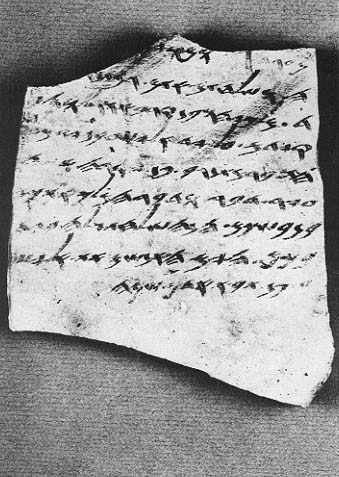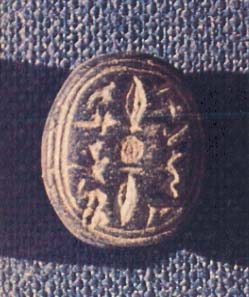Over 20 years ago, I was excavating a room on the south side of the Israelite fortress at Arad—it was the 1964 season—when Miriam Aharoni, wife of the director of the dig, came rushing over to warn us to be especially careful. We were uncovering an archive of old Hebrew letters, she shouted excitedly.
Mrs. Aharoni knew this—and we didn’t—because she had been “dipping” the potsherds from the previous day’s excavation of this area. The “dipping method,” now common on excavations in Israel, was originated by her husband Yohanan Aharoni at Arad. Each sherd is doused in water and examined to see whether it contains an inscription that cannot otherwise be observed because of the dust and dirt clinging to it. If no inscription appears, a light brush is then applied to see whether such an inscription is under dirt still stuck to the sherd. Dipping requires an extraordinary effort, because any Near Eastern dig will uncover thousands of sherds, but the results are often worth the effort. That was certainly true at Arad.
Thanks to dipping, a rich collection of epigraphic materials was unearthed at Arad, including political, administrative and cultic documents. We have already described one of two bowls incised with two Hebrew letters, q and k, probably standing for qo
Over 80 other Hebrew inscriptions were found at Arad because of the special care taken to insure that none was overlooked. Moreover, unlike the rare collections of inscriptions found at other sites in Israel, the Arad inscriptions range over a period of 350 years, covering six different strata. As a result, we can study the development of cursive Hebrew script—so-called old Hebrew (as opposed to the later square Hebrew script)—from the United Monarchy, say about 950 B.C., to the Babylonian conquest of Judah in the early sixth century B.C.
We were excavating in stratum VI on that day in 1964 when Mrs. Aharoni came running over to tell us that we had uncovered an archive. It turned out to be the largest collection of inscriptions found at Arad—18 different documents. Stratum VI was the last stratum before the fort was destroyed in the early sixth century, just before the Babylonians destroyed Jerusalem. Without knowing it, we had been digging in the office of the Israelite commander of the Arad fort.
His name was Eliashib son of Eshiyahu. Three of his seals were found on the floor of a room on the south side of the fort in stratum VII (c. 620–597 B.C.). They are beautifully preserved seals that simply read “[Belonging] to Eliashib son of Eshiyahu” in two lines. Remnants of a string were even found threaded in two of the seals. It is interesting that they are “private” seals, although we now know from the archive that Eliashib was not a private citizen, but was in fact a responsible officer of the fort. This suggests that other so-called private, as opposed to royal, seals probably belonged to important government officials even though they did not bear titles.
Eliashib may have been commander of the fort. He not only served there during stratum VII, as we know from the seals, but also in stratum VI, as we know from the archive found in his office.
Yohanan Aharoni believed the fort was occupied by the Egyptians in stratum VII because in the same room of stratum VII where the Eliashib seals were found, an ostracon was found written entirely in Egyptian hieratic (cursive) script. The ostracon appears to record an inventory of stock stored at Arad. In 609 B.C. Pharaoh Necho attacked Judah, cutting a swath from south to north, finally killing the Judahite king Josiah at the battle of Megiddo (2 Kings 23:29–35; 2 Chronicles 35:20–36:4). Aharoni assumed the Egyptians occupied the fort at Arad in connection with Necho’s campaign in Judah and that an Egyptian scribe wrote the ostracon. However, a very similar ostracon in Egyptian hieratic was found at the contemporaneous Judahite fort at Kadesh-Barnea.a
But the Kadesh-Barnea ostracon also contains a word written in Hebrew. This shows that the Arad ostracon, like the one at Kadesh-Barnea, was written by a Hebrew-speaking scribe. Indeed, Egyptian symbols for numerals and measures, as well as for commodities, are found in Hebrew inscriptions not only from the southern kingdom of Judah but even from the northern kingdom of Israel.
In my view, stratum VII at Arad was destroyed not by Pharaoh Necho, but by the “bands of raiders” sent by Nebuchadnezzar, the Babylonian ruler who later destroyed Jerusalem in 587 B.C. These raiders probably destroyed stratum VII at Arad in a softening up operation against Judah in 598/597 B.C. (2 Kings 24:12, 12; Jeremiah 13:18–19).
The fort was then rebuilt by Eliashib, who continued as commander. The most likely historical background to account for the reconstruction of the Arad fortress (stratum VI) is this: After Nebuchadnezzar captured the Judahite king Jehoiachin and took him back to Babylonia in chains in 598 B.C., Nebuchadnezzar placed a puppet king, Zedekiah, on the throne of Judah. Apparently, Nebuchadnezzar decided to trust Zedekiah despite some diplomatic hanky-panky and political unrest in the early years of Zedekiah’s rule (594 B.C.).
Accordingly it was probably Zedekiah who directed the rebuilding of the fortress (the stratum VI fortress) under the supervision of the old commander Eliashib.
The archive from Eliashib’s office in the stratum VI fortress gives a graphic picture of life in a major Judahite fortress at the end of the monarchy. First of all, this archive demonstrates that the maintenance of such an archive was neither extraordinary nor unique. Indeed, writing was common at administrative and military centers in Judah and Israel. Discovering Eliashib’s archive was not left to chance: Arad was small enough to be excavated in its entirety, and we took special care to find inscriptions at the site. In addition, the dry, desert environment of Arad for the most part preserved the carbon ink on the sherds.
Most of the Eliashib archive displays a uniformity of script and a fine form that indicate the documents were written by professional scribes. The few crude exceptions only emphasize this conclusion. It seems that a professional scribe was included in the cadre stationed at Arad.
A number of ostraca in the archive appear to be vouchers presented to Eliashib as commander of the fortress for the issuance of supplies from the fortress storehouses. Unfortunately, the vouchers do not contain the names of the senders. But it is clear from other letters that various groups passed through Arad and were provisioned there. For this purpose, at the beginning of their journey they were given vouchers addressed to Eliashib with specific instructions as to the amount and type of provisions they were to be issued.

The vouchers thus authorized the release of provisions from the fortress storehouses. The administrators of Arad then kept the vouchers as receipts. Apparently, Eliashib was instructed, according to standard practice, to write on the back the date he satisfied the voucher; one of the vouchers states: “To Eliashib: And now [the standard opening], give the Kittiyim three bathsb of wine, and write the name of the day.” The voucher goes on to list the amount of flour to be issued. On the back of one of the vouchers, the date is written in a handwriting different from that on the front.
The usual provisions kept in the storehouses, as indicated on the voucher referred to above, were wine and flour or bread. These are the basic provisions mentioned in the Bible as provisions for the road (compare Genesis 14:18; Joshua 9:4–5, Judges 19:19; 1 Samuel 10:3, 16:20, 25:18; 2 Samuel 16:1–2).
Kittiyim, referred to in the voucher discussed above, are mentioned frequently in the ostraca. These are the Kittim of the Bible. The name comes from Kition, a city on the Mediterranean island of Cyprus where the population was mainly of Phoenician origin. The Kittim thus spoke a language closely akin to Hebrew, and could easily converse with Eliashib. These Kittim or Kittiyim might have been mercenaries in the service of Judah.
In one ostracon the Kittim are given provision for “the four days”: “To Eliashib: And now give the Kittiyim two baths of wine for the four days, and 300 [loaves of] bread.” The voucher obviously came from a person of higher rank than Eliashib for it also admonishes him somewhat testily, “Don’t delay.” The use of the definite article “the” in “the four days” suggests that there must have been a definite organized route and way stations through the desert based on units of distance per day. This was not provision for “a” four-day journey, but for “the” four-day journey, probably with specific stopovers and a final destination, in this case, probably Kadesh’Barnea, where the unit of Kittiyim would be reprovisioned.
We can also draw some conclusions as to the size of the military unit from the amount of the provision.
When Zedekiah imprisoned the prophet Jeremiah, Jeremiah was allotted a ration of one loaf of bread a day (Jeremiah 37:21), no doubt a minimal portion, which is why it is specifically mentioned. Military units traveling in the desert were also minimally supplied—say two loaves a day for each man. If this is accurate 300 loaves of bread for four days indicates a unit of about 35–40 men (who would be given two loaves of bread each for four days).
One of the letters in the Eliashib archive refers to “the Temple of Yahweh.” It is a cryptic reference addressed to Eliashib from one of his subordinates: “To my lord Eliashib, May Yahweh seek your welfare. And now: … as to the matter which you commanded me—it is well; he is in the Temple of Yahweh.” The reference could not be to the temple at Arad for that had long ago been destroyed. The reference must be to the Temple of Jerusalem. Apparently, Eliashib sent one of his subordinates on a mission to Jerusalem and this is his report. Alas, the details of this mission to Jerusalem were not given.
The most chilling episode in Eliashib’s career came to light three years after the discovery of the archive in his office. I was supervising the excavation of the slope outside the fortress on the western side. An American volunteer from the University of North Carolina came running over with an inscribed sherd she had just found. It was a letter to Eliashib, but unfortunately only the back side was well preserved. From the script, we could tell that it had come from the stratum VI fortress. It was an order to rush troops from Arad and from neighboring Kinah to strengthen the defenses of Ramat-Negeb (probably Tel ‘Ira, southwest of Arad on a hill overlooking the entire Beer-Sheba Valley): “To Eliashib … king … troop … from Arad 50 and from Kin[ah] … and you shall send them to Ramat-Negeb. … ” The message is stringent—not to say hard-boiled: “The word of the king is incumbent on you for your very life! Behold I have sent to warn you today.” Ramat-Negeb had to be defended, “lest Edom should come there.”
When the Edomites to the south and east saw that Judah was under heavy pressure from the Babylonians, the Edomites invaded the Negeb, occupied southern Judah and even cheered when Nebuchadnezzar destroyed Jerusalem (Obadiah 1:10, 14; Psalm 137:7).
It was in this probable context that Eliashib was ordered to rush troops from Arad and Kinah for the defense of Ramat-Negeb. This defense probably failed.
Eliashib’s office (where the archive was found) and his dwelling quarters were destroyed by fire, probably the work of these same Edomite troops.
Another sherd found elsewhere mentions the “Son of Eliashib.” But nothing is known of the son’s fate—or of Eliashib’s.
The Eliashib letters and the other inscriptions discovered at Arad now comprise the most valuable corpus of ancient Hebrew inscriptions from the period of the Israelite monarchies.
MLA Citation
Footnotes
See Rudolph Cohen, “Did I Excavate Kadesh-Barnea?” BAR 07:03).




